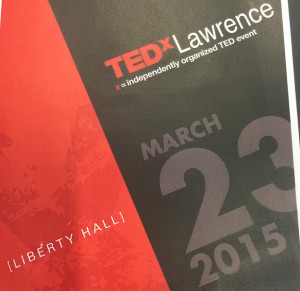 TEDxLawrence. What a day. My brain is far too full. Ever since I attended TEDxOKC four years ago, I’ve wanted to go back to another TEDx event, and was excited to get an invite to today’s event; great job to all the organizers and planners. The amount of work and logistics that went into today had to have been massive.
TEDxLawrence. What a day. My brain is far too full. Ever since I attended TEDxOKC four years ago, I’ve wanted to go back to another TEDx event, and was excited to get an invite to today’s event; great job to all the organizers and planners. The amount of work and logistics that went into today had to have been massive.
You might ask, why would I want to attend such an event, when so many of the TED and TEDx videos are online, for free, for anyone to watch?
I attend, because there is power in being in a room during a live presentation, not watching the edited version later. The energy in a TEDx event room is unlike any other event I’ve been at, and the packed schedule forces you to, at length, engage with ideas, some familiar, some unfamiliar, some you disagree with, over and over again throughout the day. It’s not a one-time inspiration, like a keynote or single session might be at a conference. These events force you to examine and connect seemingly disparate ideas, and put them together. As the Socrates quote goes, “The unexamined life is not worth living” (and I still have my college Civ For Life t-shirt). Days like today remind me that I don’t stop working long enough these days, to take the time to engage with ideas at length, write, reflect, and connect, and draw new meaning.
TEDxLawrence was much smaller than my experience at TEDxOKC, but the ideas shared were no less powerful. Ideas around creativity, that your work MATTERS, that there are many different possibility workflows (most important book Pam Grout uses? a 99c notebook), and failure.
I have a lot of notes from today, and will be slowly putting them up online throughout this next week, but I wanted to comment briefly to two talks that I found to be very much connected.
A video of Sally Kohn’s TED@NYC talk, “Let’s try emotional correctness” was shown AFTER Mick Murray’s live talk, “Faith & Science — Healing a Divide”, a very tough topic to tackle publicly, especially in Lawrence, KS.
I wish Sally’s video had been shown before Mr. Murray’s talk. Mr. Murray lost his place in his talk a few times, and there was a lot of awkward silence in the crowd, and seemingly very little support or encouragement as Mr. Murray worked to find his place again in his talk.
For a town that prides itself on being open to ideas, it was as if the crowd was almost gleeful that Mr. Murray was stumbling through his explanation — and gasp — failing, something that speaker after speaker today said was necessary for insight, for success. Mr. Murray may have thought he failed in reaching his audience, speaking to faith and science needing to dialog more — that they are not necessarily diametrically opposed.
Later, someone said she said him slip out of the event, looking very down. I felt terrible when I heard that because, for me, at least, his talk resonated and it resonated even more so, because the pauses forced me to listen more, to look closer at what he was saying, and recognize some of his points go beyond the faith and science debate.
He said, “It’s the dogmatism on one end or the other that prevents us from having a conversation about how the two can overlap.”
This statement holds true for MUCH of our society today, particularly politics. People yell past each other, stay in their comfort zones; don’t stop and listen to one another. As Kohn said later, “we don’t spend enough time talking through our disagreements. We need to find compassion and build common ground.”
Mr. Murray said that we need to “Lay down the religious dogmatism on one end and the scientific intolerance on the other….If we’re suppressing certain conversations from entering society in the name of political correctness, where does that leave us?”
For the moment, that’s where TEDxLawrence is leaving me. Not the much-needed job inspiration as my workplace enters a new era with a new director (Congrats Laura DeBaun!) or the power of partnerships to recreate and revive neighborhood schools — which definitely also happened.
TEDxLawrence challenged me to work to continue to figure out how to get people from different perspectives to stop the yelling, to listen to each other, truly listen to each other, with empathy, with compassion, and see what develops from that. And that’s an idea worth spreading.
